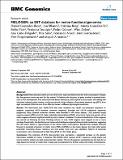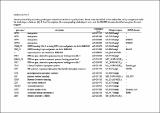Por favor, use este identificador para citar o enlazar a este item:
http://hdl.handle.net/10261/3395COMPARTIR / EXPORTAR:
 SHARE SHARE
 CORE
BASE CORE
BASE
|
|
| Visualizar otros formatos: MARC | Dublin Core | RDF | ORE | MODS | METS | DIDL | DATACITE | |

| Título: | MELOGEN: an EST database for melon functional genomics |
Autor: | González-Ibeas, Daniel CSIC ORCID; Blanca, José M.; Roig, Cristina; González-To, Mireia; Picó-Silvent, Belén; Truniger, Verónica CSIC ORCID ; Gómez, Pedro CSIC ORCID ; Deleu, Wim; Caño-Delgado, Ana I. CSIC ORCID; Arús, Pere CSIC ORCID; Nuez, Fernando; García-Mas, Jordi CSIC ORCID; Puigdomènech, Pere CSIC; Aranda, Miguel A. CSIC ORCID | Fecha de publicación: | 3-sep-2007 | Editor: | BioMed Central | Citación: | BMC Genomics. 2007; 8: 306 | Resumen: | [Background] Melon (Cucumis melo L.) is one of the most important fleshy fruits for fresh consumption. Despite
this, few genomic resources exist for this species. To facilitate the discovery of genes involved in essential traits,
such as fruit development, fruit maturation and disease resistance, and to speed up the process of breeding new
and better adapted melon varieties, we have produced a large collection of expressed sequence tags (ESTs) from
eight normalized cDNA libraries from different tissues in different physiological conditions. [Results] We determined over 30,000 ESTs that were clustered into 16,637 non-redundant sequences or unigenes, comprising 6,023 tentative consensus sequences (contigs) and 10,614 unclustered sequences (singletons). Many potential molecular markers were identified in the melon dataset: 1,052 potential simple sequence repeats (SSRs) and 356 single nucleotide polymorphisms (SNPs) were found. Sixty-nine percent of the melon unigenes showed a significant similarity with proteins in databases. Functional classification of the unigenes was carried out following the Gene Ontology scheme. In total, 9,402 unigenes were mapped to one or more ontology. Remarkably, the distributions of melon and Arabidopsis unigenes followed similar tendencies, suggesting that the melon dataset is representative of the whole melon transcriptome. Bioinformatic analyses primarily focused on potential precursors of melon micro RNAs (miRNAs) in the melon dataset, but many other genes potentially controlling disease resistance and fruit quality traits were also identified. Patterns of transcript accumulation were characterised by Real-Time-qPCR for 20 of these genes. [Conclusion] The collection of ESTs characterised here represents a substantial increase on the genetic information available for melon. A database (MELOGEN) which contains all EST sequences, contig images and several tools for analysis and data mining has been created. This set of sequences constitutes also the basis for an oligo-based microarray for melon that is being used in experiments to further analyse the melon transcriptome. |
Descripción: | This article is available from: http://www.biomedcentral.com/1471-2164/8/306 | URI: | http://hdl.handle.net/10261/3395 | DOI: | 10.1186/1471-2164-8-306 | ISSN: | 1471-2164 |
| Aparece en las colecciones: | (IBMB) Artículos (CEBAS) Artículos |
Ficheros en este ítem:
| Fichero | Descripción | Tamaño | Formato | |
|---|---|---|---|---|
| picrender.pdf | Principal | 478,43 kB | Adobe PDF |  Visualizar/Abrir |
| 1471-2164-8-306-S1.pdf | Archivo adicional 1 | 111,46 kB | Adobe PDF |  Visualizar/Abrir |
CORE Recommender
PubMed Central
Citations
38
checked on 21-abr-2024
SCOPUSTM
Citations
84
checked on 19-abr-2024
WEB OF SCIENCETM
Citations
76
checked on 25-feb-2024
Page view(s)
616
checked on 24-abr-2024
Download(s)
479
checked on 24-abr-2024
Google ScholarTM
Check
Altmetric
Altmetric
Artículos relacionados:
NOTA: Los ítems de Digital.CSIC están protegidos por copyright, con todos los derechos reservados, a menos que se indique lo contrario.
